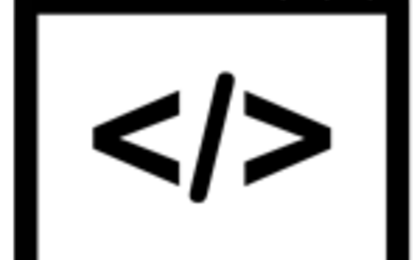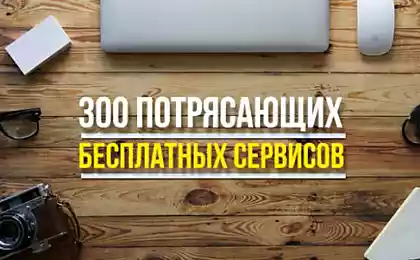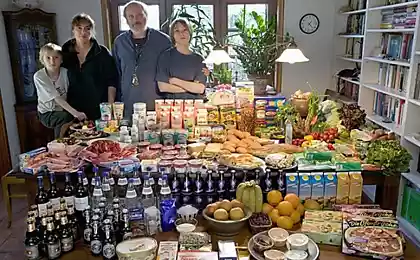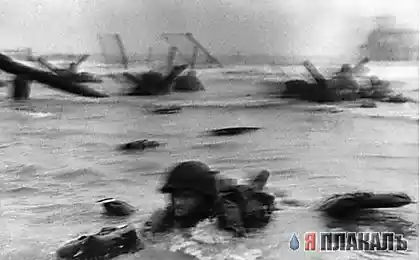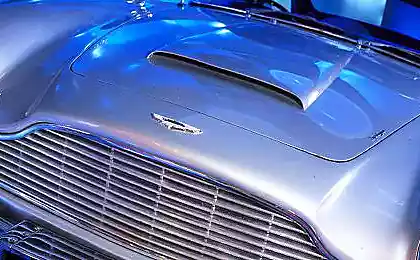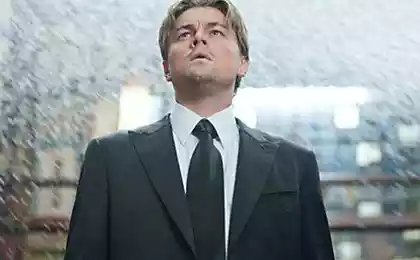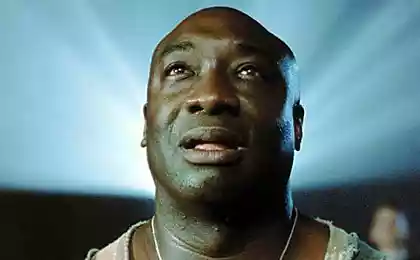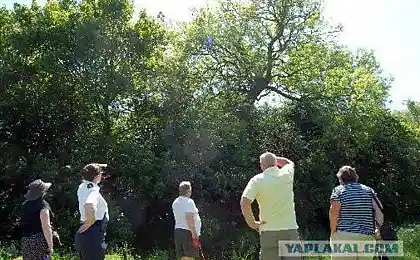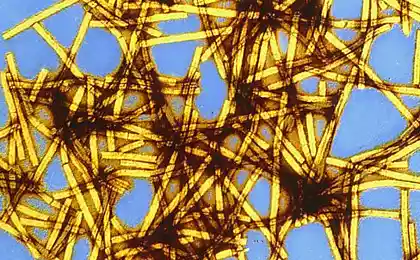842
In pursuit of cod (33 photos)
Every winter Arctic cod makes its ritual, millions of fish travel a thousand kilometers from the waters of the Barents Sea to Lofoten to spawn in the warm waters, "fueled" by the Gulf Stream. For Borge Iversen, my friend, the Norwegian captain with an exceptionally distinctive appearance sailor and Viking winter - difficult, but the most interesting time. Every 2-3 days he goes out at night from the harbor fishing town Balshtad into the open sea to catch cod 12-15 hours. To understand how people live in Lofoten, and how to catch almost 3 tons of cod with their own hands for one night - I went on a journey together with Borge.
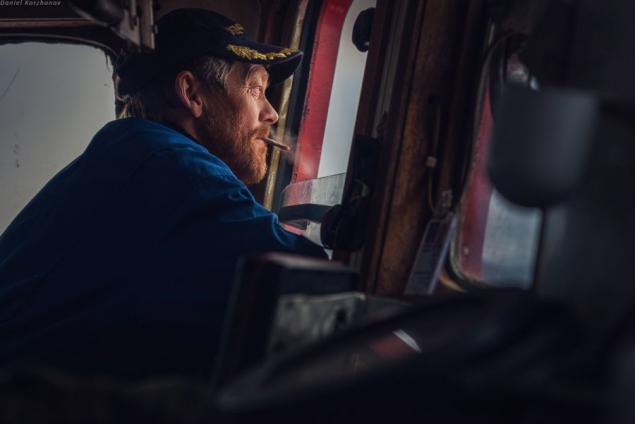
Borge, like all Norwegian sailors, very open and welcoming sailor. He is 40 years out at sea fishing. Winter - a serious work, cod fishing, and in summer - guided tours, individual fishing tours. His ship for 26 years, and most of his life Borge spent on it.
A cold wind from the sea blows remnants of snow on the wharf, and I tell Borge, we survived the storm last night in a fisherman's hut - rorbu. Borge such tales of swaying houses do not surprise: the winter storms are frequent in Lofoten. But he decides to go into the open sea during the day and not at night. Why at night? Borge answers, "so you need to ship the fish to catch in the morning to the warehouse guys in the warehouse work the day shift." Indeed, the Norwegians fishing season - from January to April, a total of 4 months of the year. It was at this time comes for spawning cod in Lofoten.

In anticipation of the interesting adventure Borge we hit the road. The ship slowly sails away from the wet dock rocking on the waves of harbor weak. Borge usual endless maneuvering between rocks and lighthouse, shore bristled Balshtada. At the same time to look with one eye Championships Biathlon on a small TV in the cabin. Again, the Norwegians beat Russian in the final - Borge slightly jeering at me, promising an uphill battle with the Norwegians on the Russian Olympics in Sochi. Meanwhile, the Borg ship out of the harbor - and we immediately feel nature stormy sea. The ship, like a chip, flips from the crest of the ridge dark restless waves. While I was throwing from side to side, Borge, swaying in the captain's chair, calmly explains where we are going, showing his usual way. After 2 hours, we have to go out to sea, away from the islands, and start fishing. Borge Catches cod in the traditional way, which has been at least 500 years. They call it "long lines" or longline fishing method.
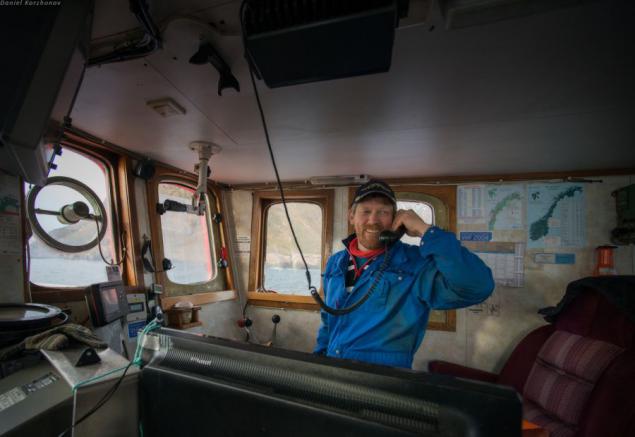
How do we currently feel? Say bad - lie. We have half an hour to turn up the beginning of the path. The children, the poor members of our photo tour on his head, too, asked for me on the ship.
First, in the bay, it was relatively quiet. Especially when you are in the bay. They went out into the sea - was worse, but tolerable: we flew only from wall to wall, touching the ceiling More ...
But the night began. Then I put the camera to take a more important matter.
Poor guys the whole trip in pain and suffering, green, lay here on these cots. They have not been able to even get them to see that this kind of traditional fishing.
No wonder Børge we warned at the beginning: backpacks aboard - a bad omen! True. But late - backpacks were no longer needed.
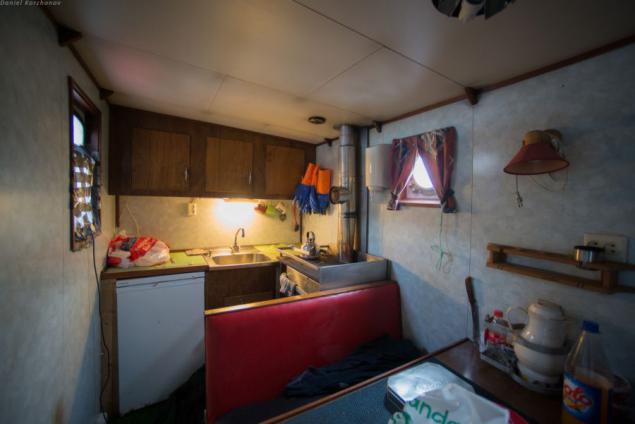
Exit the calm bay. Last time you can stand for anything not holding.
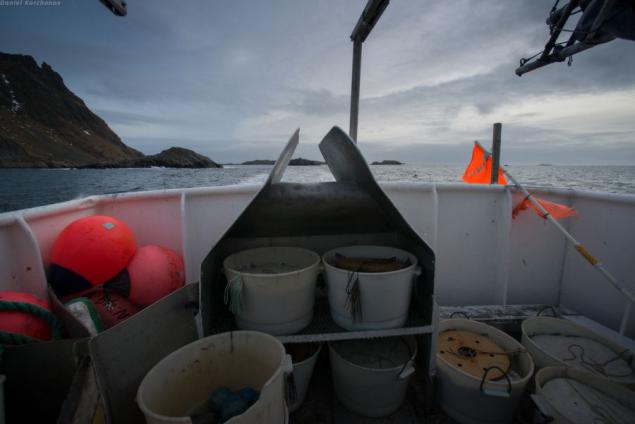
- You see these colorful line? - Borge points to monitor, nailed to the ground and fixed to the corners. - This is the "long lines" or bunk line. Simply put, Borge stretches the length of fishing line (750 meters) with a large number of hooks with bait and then collect the catch, pulling the line on board with special drums. Borge now much easier to swim, and he controlled the ship and fishing alone. He just puts the ship on autopilot, synchronized with a computer navigation system. To me, he made an exception, taking on board. He says that sometimes you want to talk, to tell an interesting story ... Young points to a yellowed by time, Compass, "is - the heart of the ship, without it you can not go to sea, any electronics can fail, and the compass will never let you down."

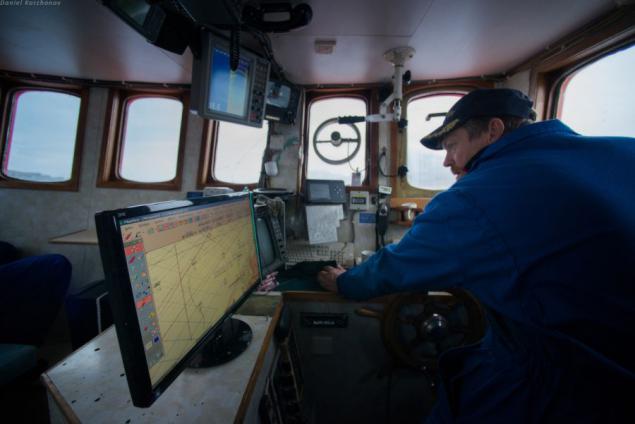

Echoes of the night of the storm are felt: in the open sea waves 4-5 meters high. Borge jokingly supports me, clinging to some detail at hand, calling the process "flight" of the ship from the waves to wave "surfing." For the body, unaccustomed to the sea, are important empty stomach and fresh air. And then, and another is already available, so after a while the flight from one to the other captain's cabin come to life. Borge just slows down and we start looking for the beginning of the "line" - it is marked with a reflector buёm. Already it is beginning to get dark, but a keen eye Borge quickly finds a red marker -flazhok between wave crests. The ends of the lines are anchored and are at different depths. Depth controlled buoys. Borge catches buoy - and begins to choose a rope, to find the end of the fishing line. But here we are waiting for the failure: the fishing line is detached from the rope. Apparently, the storm messed nenadezhdny node. Or, he says a bad omen: I took on board his backpack with photographic equipment, and it is a bad sign for the sailors. By the way, the backpack made itself felt, flying from the floor almost to the ceiling the cabin, while I was not tied to a table leg ...
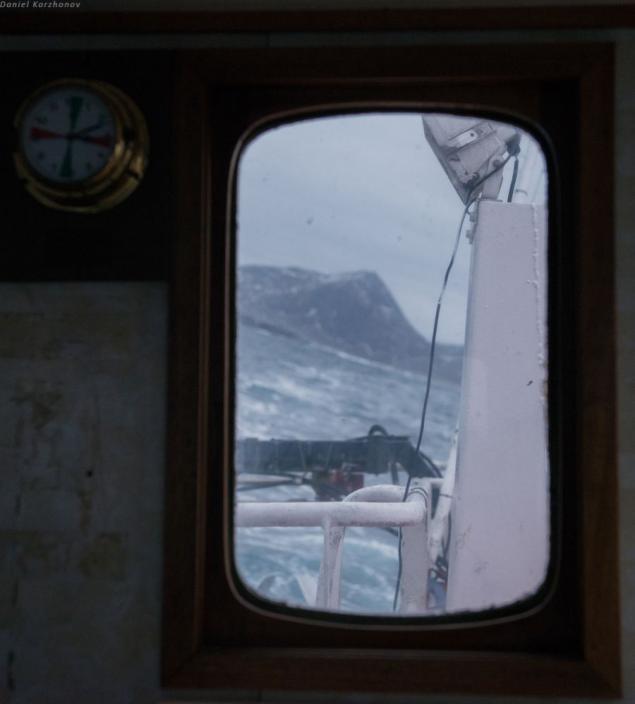
Borge is very much worried about the authorities' actions, commenting on the desire of large oil companies to develop new offshore fields: "Fishing - the foundation of life of people in Lofoten, part of their traditions and way of life. Lofoten is home to around 25,000 inhabitants, and almost every other resident in any way associated with the sea. More than 500 ships out to catch cod in the winter. I'm sure that 99% of fishermen in Lofoten against the deployment of new drilling rigs in the ocean shelf. More than 1, 7 billion tons of cod lives in the Barents Sea, and some come to Lofoten to spawn. Any problem in the rig could lead to a global catastrophe. "
Borg is confident that the development of the shelf off Lofoten - just a matter of time. Norway - the richest country in the world precisely because of the oil, and the oil needle does not let the country. Northern deposits gradually depleted, and Lofoten, the most promising area for Statoil, the Norwegian oil company, still remains intact.
Some analysts estimate the oil fields in the 1, 3 billion barrels. Norway ranks third in the world in terms of oil exports. A small population of Norway has made it a very rich country. Oil domestically consumed in very small quantities, and in the oil industry are not allowed international companies. Yes, and the government controls the country's resources wisely: oil in Norway really belongs to the people. By the way, between Norway and Russia is constantly debate over the ownership of coastal shelf of the Barents Sea. In any case, life Lofoten change much in the coming desyateletiya if the oil industry will reach the archipelago.
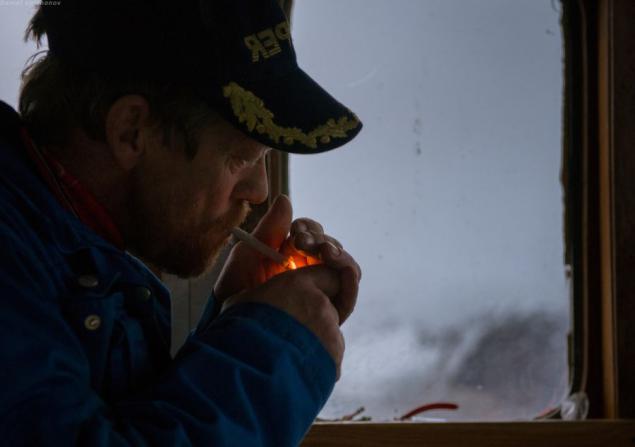
We swam to the other end of the line tier, also caught the anchor rope - and here, fortunately, the line was on the spot. Borge end planted on a large drum with a motor-driven vehicle, and began pulling the line, putting the ship on a quiet move, indicating the end of the line on autopilot. So about 2 hours we drifted and caught cod. Here it is - the first fish! Arctic cod in Norwegian sounds like "Skrei", which literally means "traveler". Every 3-5 meters on the line of hooks with bait. Borge stands at the edge of the swinging ship on the waves, and deft movement gaff (a stick with a hook on the end) pulls the fish overboard as soon as the hook close to the drum. Given that Borge is now in its sixth decade, agility old sailor just struck me: just one hand on the second Borg throws a fish weighing up to 25 pounds in a container. And then the moment: a big fish breaks off the hook, the tail of a loud plopping wave. Borge gives back up (all the levers at hand) intercepts a stick-spear and promptly return the fugitive aboard. All this happens so quickly that it does not have time to figure out how the fish ended up in the container. After all monofilament line is wound into a large container, Borge fish kills, piercing it with a knife at the gills, and then shifts it to the container with water.

Hones hook.

Respite - cup of coffee with chocolate cookies - and back to work. Now you need to stretch a new line of fresh bait. As bait Borge uses pieces of shrimp or herring. Line unwound quite rapidly - there is no need to drift. Night had covered the sea. Now there is heavy rain, the element does not subside. Borge is no stranger in winter conditions are worse: snow storms, icing on the ship ...
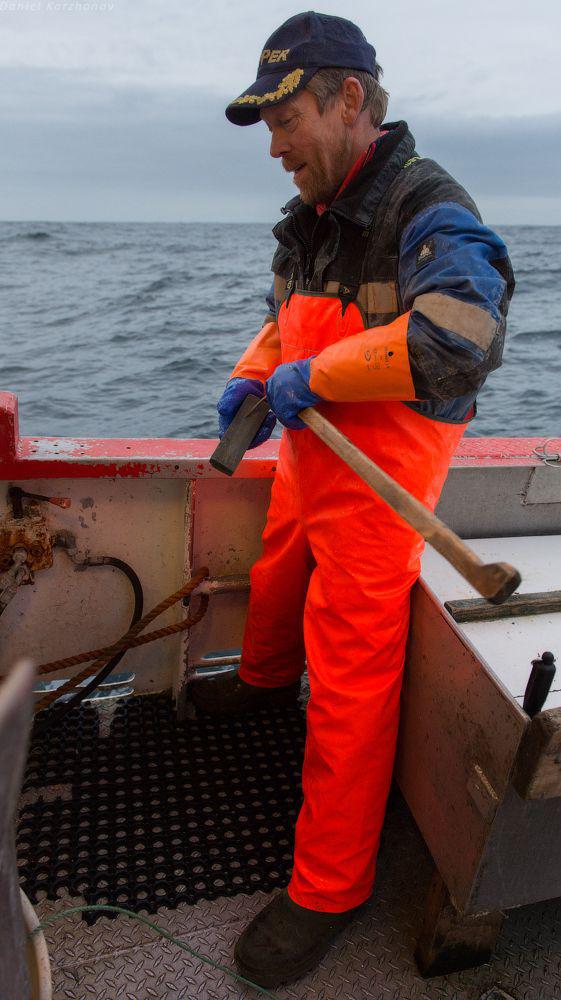
I fell asleep in the cabin Borge a couple of hours to the sound of rain and the vehicle's engine. I woke up on the third line - Borge, with the same cheerful smile offers me a cup of coffee. We're a little off course: it turned out, in the course of its flight control room, I knocked lightly electronics, and had a little tricky to reconfigure devices. Borge slightly stiffened without navigation electronics in such a storm, and a wall of rain is very difficult to get out to the home land among the sharp rocks Lofoten. But nothing, trimmed all the devices have high reliability. Look out for the last marker, scanning the sea of powerful flashlight. 3-4 laps around the surrounding points on the map - and we see the reflection of the reflector buoys.

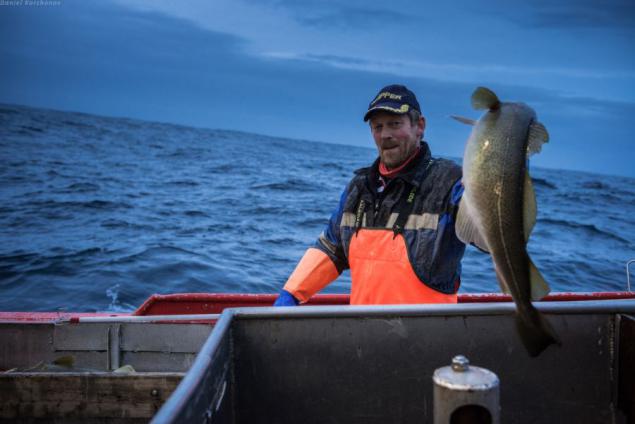



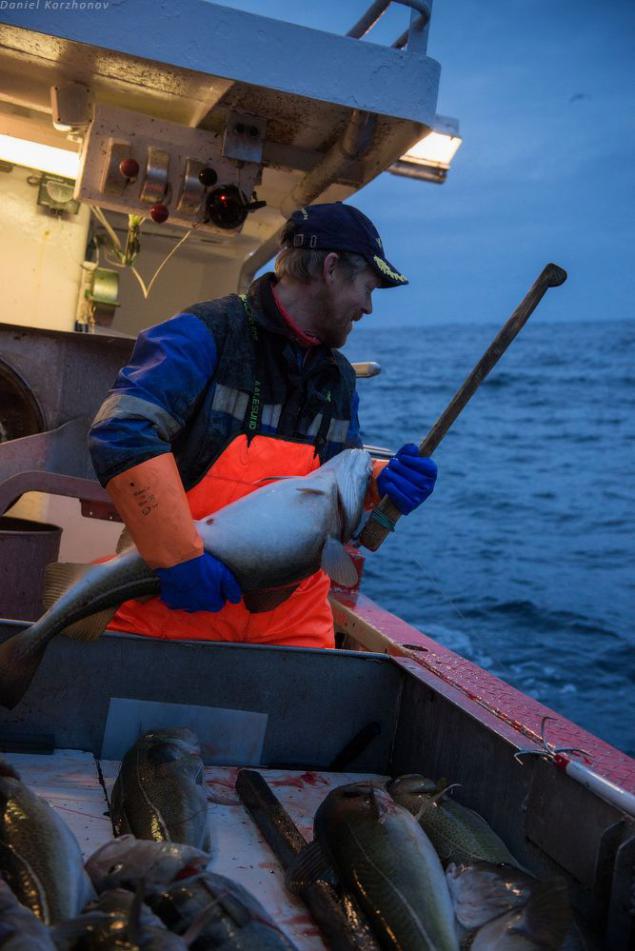
Another 2 hours - and finished third line: Borge returned to the cabin, and we again have time to talk.
-Today Catch - 500 fishes, it is about 1, 5 tons of fish - says Borge. -This Is a good result. I have a quota for seasonal catch of fish: allowed to catch about 100 tonnes of cod per season. Government regulates and fishing grounds and quotas: Borge is obliged to fill in a logbook.
But why Borge uses the traditional method of fishing, trawl catches, do not use the network? The captain himself answers: "I love my job, I love the sea and traditions of our land. When you live in harmony with mother earth, the sea, the work is fun. "
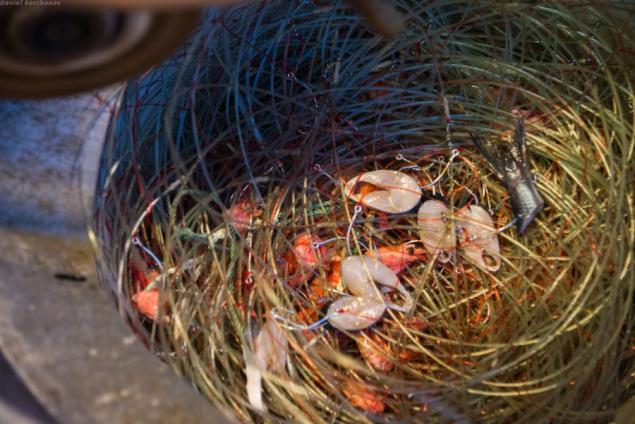
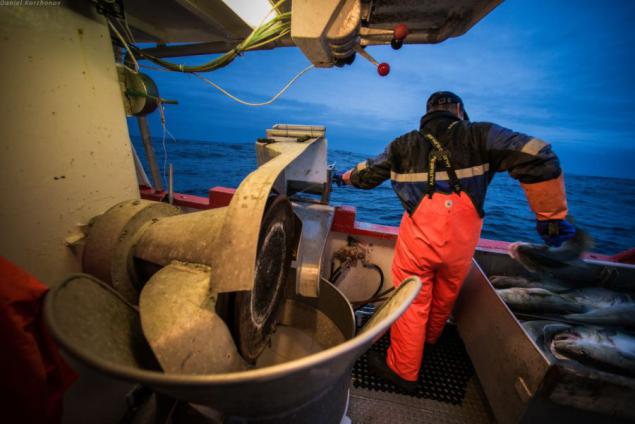
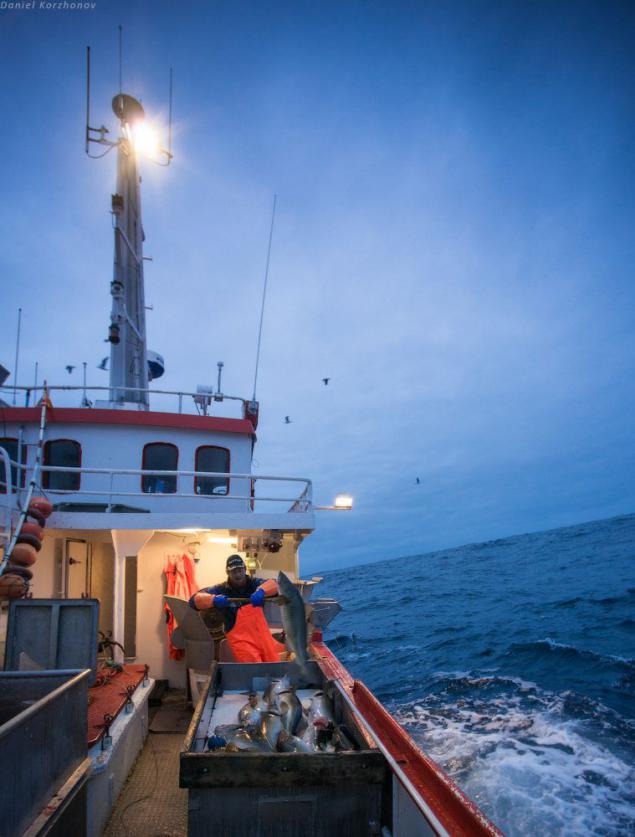
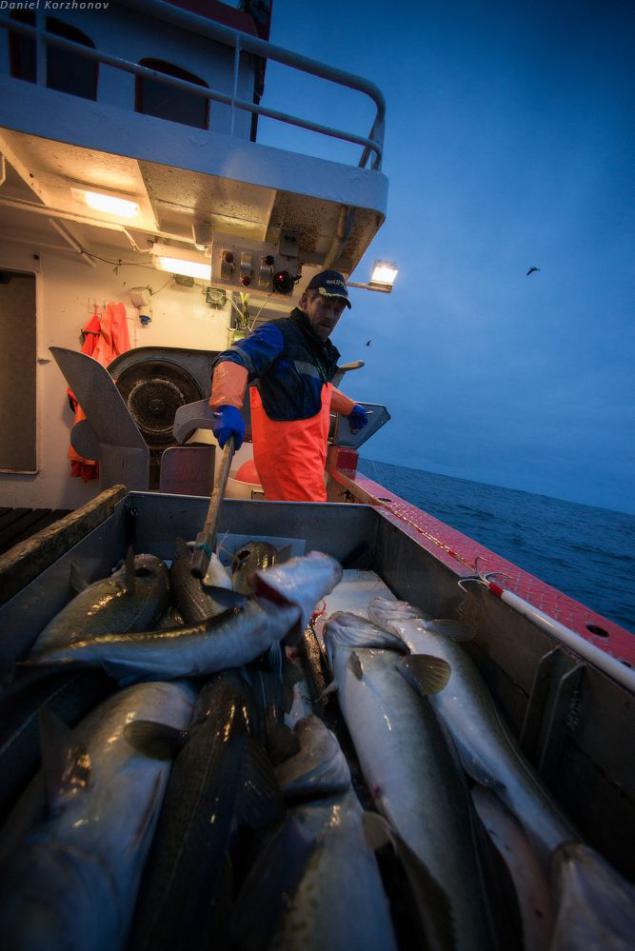
Two hours pass road home for conversation and maritime history - and only 4 in the morning we get up on solid ground. Honestly, that night, I was completely exhausted, can not be said about the Borg. His face - not the slightest trace of fatigue, but the same good-natured smile and thoughtful swinging with expressive peal «Ja, Ja, Ja ...» at the beginning of each phrase. Borge invited me to see the next day, what to do with the fish.
In a coma bags we lay down our bodies in the car and after a while turned out to be a miracle in rorbu.
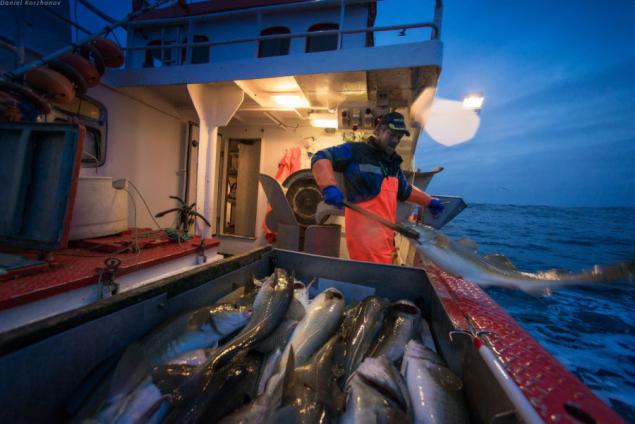
The next day, hard to tear yourself away from the bed on a cloudy day, I went back to look at the fish. I did not have to go far: in every small village of the archipelago are whole rows of poles, which is suspended or the body of the fish, or fish heads. Borge ships fish in the warehouse - and then it is treated: cut off the head, liver, eggs, language. The fish is divided into several varieties: fresh, for drying and curing. Generally, fish vyalyat. What you see in the photos - a special, characteristic only for drying fish Lofoten method: it is hanging in the open air from January to May. The fish is not pre-treated: a bind tails - and hung on poles. Lofoten optimal temperature for drying: on the one hand, it rarely falls below zero, so the ice does not break the tissue of fish, and on the other - not too high, so that flies and insects are not spoiled cod. This gull can not disrupt the associated fish on top, sitting on poles. A strong sea breeze dries quickly ligament fishes, reducing its weight by 5 times. As it turns out, "concentrated" cod, which is very convenient to carry, while it does not lose its nutritional properties and is stored for a long time. To get a little fresh fish - just add water to the soup-like sauce!
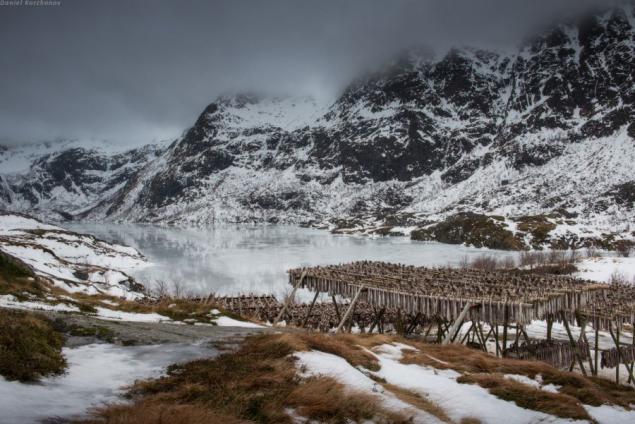

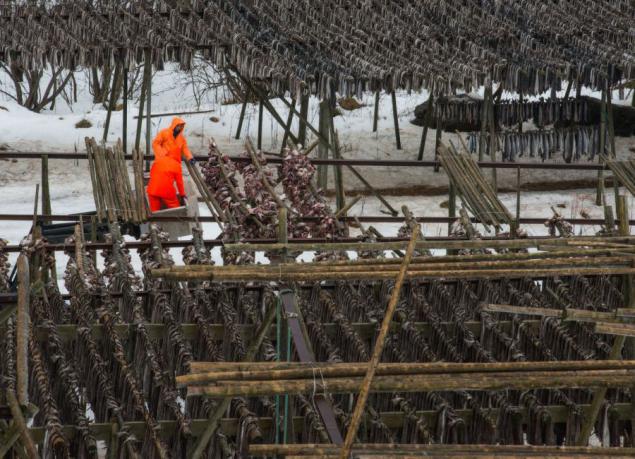
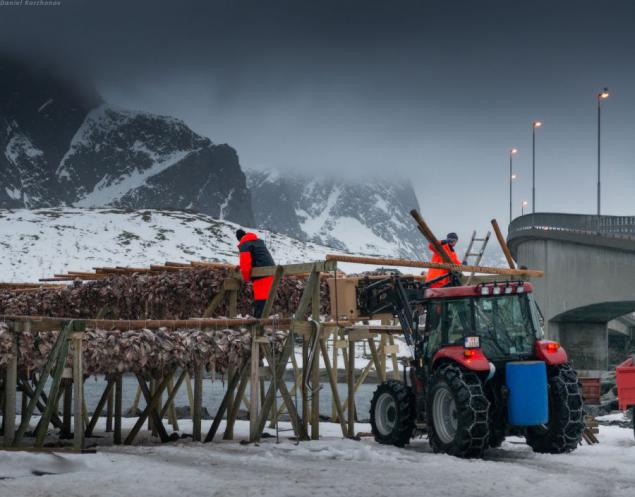
We talked with the local lads who work on his farm. Said head being taken in Africa - in the soup.
In traditional Norwegian Kjell («hjell» - poles for drying) not only hang the body of fish, but also their heads. It turns out that the head is also in high demand - they are exported to Africa and make there are soups.
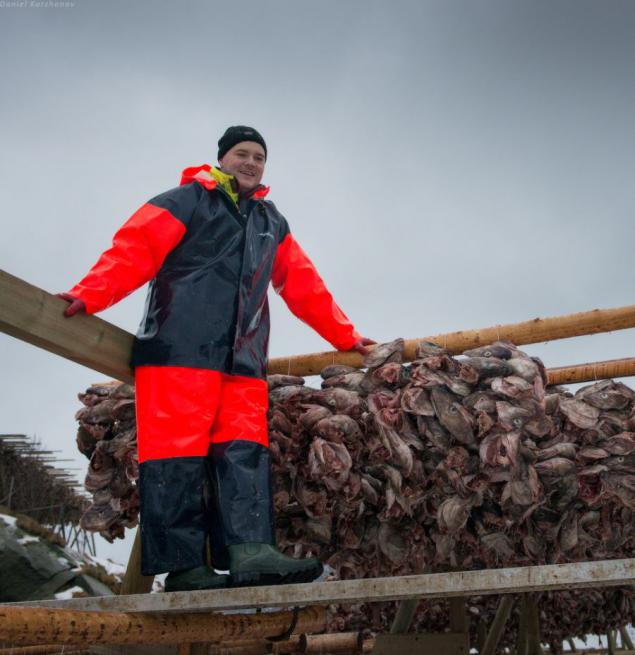
So she vyalitsya all winter.


Italians and Norwegians idolize each other: dried cod comes mainly in Italy. And he started the tradition of cooking cod in Italian cuisine Venetian merchant Pietro Querini, which is still in 1432, visited the island and brought a barrel of dried fish. Since then, the Italians are inseparable with their favorite dishes from Norwegian cod.
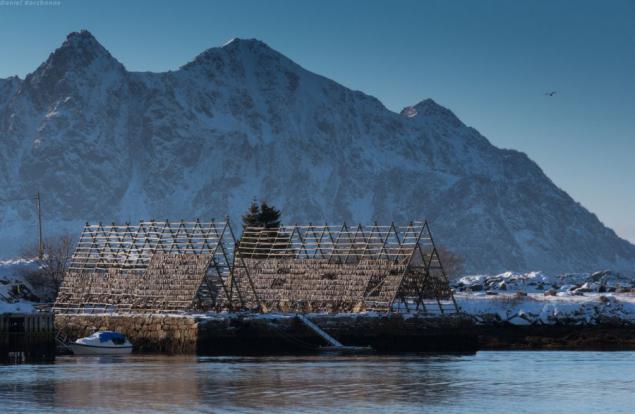
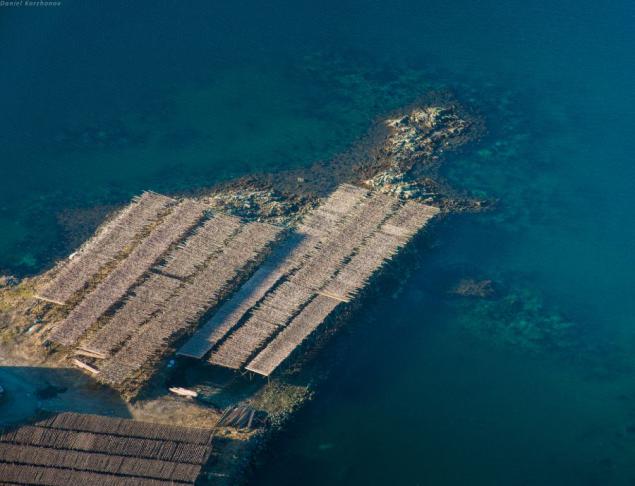
The next morning I met Borge. He greeted me cheerfully, after the next single night fishing. To the question "like fishing?" Received the answer:
- One thousand!
-One Thousand kilo - ton? - I asked.
- No - one thousand fishes, only 3 tons! And the biggest weighed about 30 kilograms!
satorifoto

Borge, like all Norwegian sailors, very open and welcoming sailor. He is 40 years out at sea fishing. Winter - a serious work, cod fishing, and in summer - guided tours, individual fishing tours. His ship for 26 years, and most of his life Borge spent on it.
A cold wind from the sea blows remnants of snow on the wharf, and I tell Borge, we survived the storm last night in a fisherman's hut - rorbu. Borge such tales of swaying houses do not surprise: the winter storms are frequent in Lofoten. But he decides to go into the open sea during the day and not at night. Why at night? Borge answers, "so you need to ship the fish to catch in the morning to the warehouse guys in the warehouse work the day shift." Indeed, the Norwegians fishing season - from January to April, a total of 4 months of the year. It was at this time comes for spawning cod in Lofoten.

In anticipation of the interesting adventure Borge we hit the road. The ship slowly sails away from the wet dock rocking on the waves of harbor weak. Borge usual endless maneuvering between rocks and lighthouse, shore bristled Balshtada. At the same time to look with one eye Championships Biathlon on a small TV in the cabin. Again, the Norwegians beat Russian in the final - Borge slightly jeering at me, promising an uphill battle with the Norwegians on the Russian Olympics in Sochi. Meanwhile, the Borg ship out of the harbor - and we immediately feel nature stormy sea. The ship, like a chip, flips from the crest of the ridge dark restless waves. While I was throwing from side to side, Borge, swaying in the captain's chair, calmly explains where we are going, showing his usual way. After 2 hours, we have to go out to sea, away from the islands, and start fishing. Borge Catches cod in the traditional way, which has been at least 500 years. They call it "long lines" or longline fishing method.

How do we currently feel? Say bad - lie. We have half an hour to turn up the beginning of the path. The children, the poor members of our photo tour on his head, too, asked for me on the ship.
First, in the bay, it was relatively quiet. Especially when you are in the bay. They went out into the sea - was worse, but tolerable: we flew only from wall to wall, touching the ceiling More ...
But the night began. Then I put the camera to take a more important matter.
Poor guys the whole trip in pain and suffering, green, lay here on these cots. They have not been able to even get them to see that this kind of traditional fishing.
No wonder Børge we warned at the beginning: backpacks aboard - a bad omen! True. But late - backpacks were no longer needed.

Exit the calm bay. Last time you can stand for anything not holding.

- You see these colorful line? - Borge points to monitor, nailed to the ground and fixed to the corners. - This is the "long lines" or bunk line. Simply put, Borge stretches the length of fishing line (750 meters) with a large number of hooks with bait and then collect the catch, pulling the line on board with special drums. Borge now much easier to swim, and he controlled the ship and fishing alone. He just puts the ship on autopilot, synchronized with a computer navigation system. To me, he made an exception, taking on board. He says that sometimes you want to talk, to tell an interesting story ... Young points to a yellowed by time, Compass, "is - the heart of the ship, without it you can not go to sea, any electronics can fail, and the compass will never let you down."



Echoes of the night of the storm are felt: in the open sea waves 4-5 meters high. Borge jokingly supports me, clinging to some detail at hand, calling the process "flight" of the ship from the waves to wave "surfing." For the body, unaccustomed to the sea, are important empty stomach and fresh air. And then, and another is already available, so after a while the flight from one to the other captain's cabin come to life. Borge just slows down and we start looking for the beginning of the "line" - it is marked with a reflector buёm. Already it is beginning to get dark, but a keen eye Borge quickly finds a red marker -flazhok between wave crests. The ends of the lines are anchored and are at different depths. Depth controlled buoys. Borge catches buoy - and begins to choose a rope, to find the end of the fishing line. But here we are waiting for the failure: the fishing line is detached from the rope. Apparently, the storm messed nenadezhdny node. Or, he says a bad omen: I took on board his backpack with photographic equipment, and it is a bad sign for the sailors. By the way, the backpack made itself felt, flying from the floor almost to the ceiling the cabin, while I was not tied to a table leg ...

Borge is very much worried about the authorities' actions, commenting on the desire of large oil companies to develop new offshore fields: "Fishing - the foundation of life of people in Lofoten, part of their traditions and way of life. Lofoten is home to around 25,000 inhabitants, and almost every other resident in any way associated with the sea. More than 500 ships out to catch cod in the winter. I'm sure that 99% of fishermen in Lofoten against the deployment of new drilling rigs in the ocean shelf. More than 1, 7 billion tons of cod lives in the Barents Sea, and some come to Lofoten to spawn. Any problem in the rig could lead to a global catastrophe. "
Borg is confident that the development of the shelf off Lofoten - just a matter of time. Norway - the richest country in the world precisely because of the oil, and the oil needle does not let the country. Northern deposits gradually depleted, and Lofoten, the most promising area for Statoil, the Norwegian oil company, still remains intact.
Some analysts estimate the oil fields in the 1, 3 billion barrels. Norway ranks third in the world in terms of oil exports. A small population of Norway has made it a very rich country. Oil domestically consumed in very small quantities, and in the oil industry are not allowed international companies. Yes, and the government controls the country's resources wisely: oil in Norway really belongs to the people. By the way, between Norway and Russia is constantly debate over the ownership of coastal shelf of the Barents Sea. In any case, life Lofoten change much in the coming desyateletiya if the oil industry will reach the archipelago.

We swam to the other end of the line tier, also caught the anchor rope - and here, fortunately, the line was on the spot. Borge end planted on a large drum with a motor-driven vehicle, and began pulling the line, putting the ship on a quiet move, indicating the end of the line on autopilot. So about 2 hours we drifted and caught cod. Here it is - the first fish! Arctic cod in Norwegian sounds like "Skrei", which literally means "traveler". Every 3-5 meters on the line of hooks with bait. Borge stands at the edge of the swinging ship on the waves, and deft movement gaff (a stick with a hook on the end) pulls the fish overboard as soon as the hook close to the drum. Given that Borge is now in its sixth decade, agility old sailor just struck me: just one hand on the second Borg throws a fish weighing up to 25 pounds in a container. And then the moment: a big fish breaks off the hook, the tail of a loud plopping wave. Borge gives back up (all the levers at hand) intercepts a stick-spear and promptly return the fugitive aboard. All this happens so quickly that it does not have time to figure out how the fish ended up in the container. After all monofilament line is wound into a large container, Borge fish kills, piercing it with a knife at the gills, and then shifts it to the container with water.

Hones hook.

Respite - cup of coffee with chocolate cookies - and back to work. Now you need to stretch a new line of fresh bait. As bait Borge uses pieces of shrimp or herring. Line unwound quite rapidly - there is no need to drift. Night had covered the sea. Now there is heavy rain, the element does not subside. Borge is no stranger in winter conditions are worse: snow storms, icing on the ship ...

I fell asleep in the cabin Borge a couple of hours to the sound of rain and the vehicle's engine. I woke up on the third line - Borge, with the same cheerful smile offers me a cup of coffee. We're a little off course: it turned out, in the course of its flight control room, I knocked lightly electronics, and had a little tricky to reconfigure devices. Borge slightly stiffened without navigation electronics in such a storm, and a wall of rain is very difficult to get out to the home land among the sharp rocks Lofoten. But nothing, trimmed all the devices have high reliability. Look out for the last marker, scanning the sea of powerful flashlight. 3-4 laps around the surrounding points on the map - and we see the reflection of the reflector buoys.






Another 2 hours - and finished third line: Borge returned to the cabin, and we again have time to talk.
-Today Catch - 500 fishes, it is about 1, 5 tons of fish - says Borge. -This Is a good result. I have a quota for seasonal catch of fish: allowed to catch about 100 tonnes of cod per season. Government regulates and fishing grounds and quotas: Borge is obliged to fill in a logbook.
But why Borge uses the traditional method of fishing, trawl catches, do not use the network? The captain himself answers: "I love my job, I love the sea and traditions of our land. When you live in harmony with mother earth, the sea, the work is fun. "




Two hours pass road home for conversation and maritime history - and only 4 in the morning we get up on solid ground. Honestly, that night, I was completely exhausted, can not be said about the Borg. His face - not the slightest trace of fatigue, but the same good-natured smile and thoughtful swinging with expressive peal «Ja, Ja, Ja ...» at the beginning of each phrase. Borge invited me to see the next day, what to do with the fish.
In a coma bags we lay down our bodies in the car and after a while turned out to be a miracle in rorbu.

The next day, hard to tear yourself away from the bed on a cloudy day, I went back to look at the fish. I did not have to go far: in every small village of the archipelago are whole rows of poles, which is suspended or the body of the fish, or fish heads. Borge ships fish in the warehouse - and then it is treated: cut off the head, liver, eggs, language. The fish is divided into several varieties: fresh, for drying and curing. Generally, fish vyalyat. What you see in the photos - a special, characteristic only for drying fish Lofoten method: it is hanging in the open air from January to May. The fish is not pre-treated: a bind tails - and hung on poles. Lofoten optimal temperature for drying: on the one hand, it rarely falls below zero, so the ice does not break the tissue of fish, and on the other - not too high, so that flies and insects are not spoiled cod. This gull can not disrupt the associated fish on top, sitting on poles. A strong sea breeze dries quickly ligament fishes, reducing its weight by 5 times. As it turns out, "concentrated" cod, which is very convenient to carry, while it does not lose its nutritional properties and is stored for a long time. To get a little fresh fish - just add water to the soup-like sauce!




We talked with the local lads who work on his farm. Said head being taken in Africa - in the soup.
In traditional Norwegian Kjell («hjell» - poles for drying) not only hang the body of fish, but also their heads. It turns out that the head is also in high demand - they are exported to Africa and make there are soups.

So she vyalitsya all winter.


Italians and Norwegians idolize each other: dried cod comes mainly in Italy. And he started the tradition of cooking cod in Italian cuisine Venetian merchant Pietro Querini, which is still in 1432, visited the island and brought a barrel of dried fish. Since then, the Italians are inseparable with their favorite dishes from Norwegian cod.


The next morning I met Borge. He greeted me cheerfully, after the next single night fishing. To the question "like fishing?" Received the answer:
- One thousand!
-One Thousand kilo - ton? - I asked.
- No - one thousand fishes, only 3 tons! And the biggest weighed about 30 kilograms!
satorifoto
Makeup artist Samer Khouzami from Lebanon as a virtuoso art of make-up
The most absurd studies in science (23 photos)


